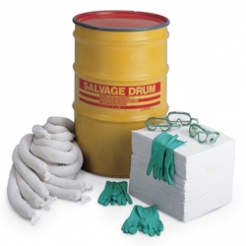
If your warehouse, factory or home workshop has a supply of hazardous materials, you may have already dealt with creating an area specifically for storing those materials. But if you’re thinking of upgrading, updating or simply replacing old storage containers, cabinets and other safety items, you’ve come to the right supplier!
We carry a large selection of safety products that will provide you with peace of mind as they assist with prevention and protection. Emergency lights, hard hats, spill containment and clean up items, and many other categories of products are available from Bahrns.com.
Here’s some advice that you may find helpful as you assess and improve your location’s hazardous material storage practices:
If you have a storage room, make sure that it’s equipped with explosion-proof electrical fixtures. The room must be properly ventilated, as well. Provide training to specific employees that may be tasked with emergency spill cleanup – the training will ensure that they can use spill cleanup equipment and have proper knowledge on what to do in case of emergency.
Before storing any flammable or combustible materials, check compatibility. This means that you check to make sure the chemicals can be stored together – chemical compatibility is almost always located on a material safety data sheet for each chemical. If there are any conflicts, you must separate incompatible chemicals by using an appropriately rated partition, or a fire wall.
An important safety consideration is making sure your business or workshop has appropriate, easy-to-access fire extinguishers. These need to be properly sized (considering the area where a fire could occur) and – just like emergency spill management – you must ensure that employees are trained to locate and operate extinguishers properly. This training could also coincide with first aid and CPR training, which saves many lives every day in workplaces around the world.
Flammable and combustible material storage is another storage and safety issue for many businesses. Flammable materials can be solids, liquids, or gases. Solids like dust and powders include desensitized explosives, self-reactive materials and readily combustible solids could ignite if exposed to friction, moisture, heat retained from processing, or a spontaneous chemical change. The U.S. Department of Transportation can provide much more detailed information on this topic, as well. Compressed gases like butane, acetylene, methane and hydrogen, and flammable liquids with a flashpoint below 100 degrees Fahrenheit must also be stored under strict safety guidelines. Information is available online from several sources, including the Occupational Safety and Health Administration.
If your business or workshop deals with any amount of alcohol, acetone, gasoline, solvents, paint thinners, wood stains, spray paints, wood, paper, diesel fuel, kerosene, oil-based paints and furniture polish, it is your responsibility to ensure that these materials are properly stored and kept safe from sparks, smokers, static buildup and other potential causes of fire. Avoid storing more flammable or combustible material than will be used in a reasonable amount of time, and be sure that what you are storing is in a safe and secure room, preferably inside fire-and-explosion-preventing storage cabinets.
